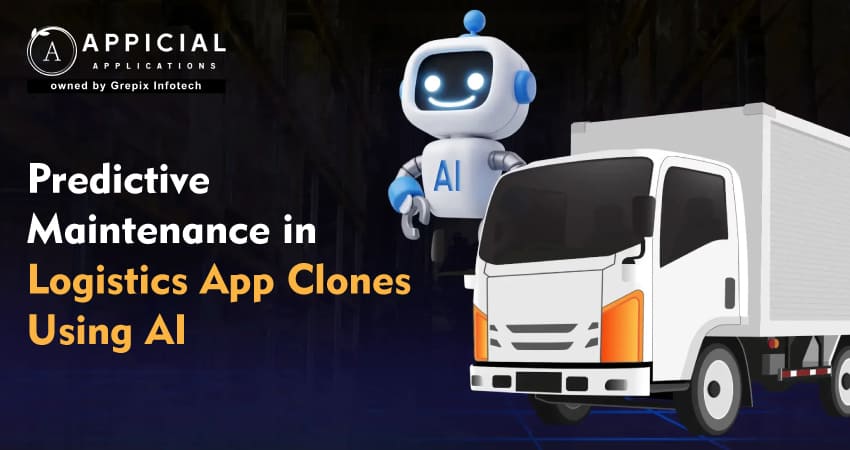
Predictive Maintenance in Logistics App Clones Using AI
Let’s get real for a second
Logistics is the heartbeat of global commerce. If the heart stops beating, delays happen, customers get angry, and companies lose money. That’s why more and more businesses are turning to predictive maintenance logistics to keep things running smoothly.
So, what’s predictive maintenance anyway?
It's not just another buzzy tech term. In plain English, predictive maintenance is about fixing things before they break. Think of it as your logistics system having a sixth sense knowing when a delivery truck’s engine is acting up or when a warehouse system is heading toward a malfunction.
Now, throw AI into the mix
With the help of AI logistics app technology, businesses can monitor everything in real time engines, routes, weather, driver behavior you name it. The system picks up anomalies, patterns, and trends, alerting you before a problem hits the fan. That’s power. That’s predictive foresight, not hindsight.
And here’s where logistics app clone maintenance becomes the hero. You don’t have to build these systems from scratch anymore. Cloning successful logistics apps (think Uber Freight, Postmates, or FedEx apps) and baking predictive features into them using AI is where the future is heading.
In this deep dive, we’re going to explore how predictive maintenance logistics is reshaping the way modern transportation and delivery systems run. You’ll discover what predictive maintenance really means, how it’s implemented in AI logistics app systems, and why it's no longer optional but a competitive necessity. From smarter trucks to error-free scheduling, we’ll look at how logistics app clone maintenance with AI is rewriting the playbook. We'll round it off with real case studies and a tip of the hat to a major player helping businesses bring this to life Appicial Applications.
Why Predictive Maintenance Is a Game Changer for Logistics?
Let’s break it down how exactly does predictive maintenance logistics benefit the industry? The short answer: in more ways than you can count. But here are the big hitters.
1. Reduced Downtime Means More Deliveries, Fewer Headaches
Imagine this: it’s Monday morning, and one of your best delivery trucks is halfway to its destination when the engine throws in the towel. Job delayed, customer frustrated, and now you're scrambling to reassign the delivery and book an emergency repair. We’ve all been there and it sucks.
Now flip the script. What if your AI logistics app had flagged unusual engine vibrations or temperature anomalies two days ago? That truck would’ve gone in for a quick inspection over the weekend, and Monday’s delivery would have gone off without a hitch.
That’s the power of predictive maintenance it gives you time to act before things go wrong. The result? Fewer breakdowns, smoother deliveries, and a lot less chaos.
2. Lower Repair Costs That Add Up to Big Savings
Emergency repairs aren't just stressful they're wildly expensive. Think tow trucks, rush parts, after-hours mechanic rates, and all the lost time while your truck sits idle. Not to mention potential penalties for delayed shipments.
With predictive tools embedded in your logistics app clone maintenance system, you shift from “fix it when it breaks” to “service it before it fails.” The system keeps tabs on your vehicle components brakes, engines, tires, batteries and alerts you when something’s about to wear out, not after it’s already toast.
This proactive approach slashes your repair bills. It also lets you plan service during off-hours or in locations where maintenance is cheaper. You save money, your trucks stay on the road, and your customers stay happy.
3. Safer Driving Conditions for Drivers and Everyone Else on the Road
Maintenance isn't just about keeping machines running it’s about keeping people safe. Your drivers are out there navigating heavy traffic, harsh weather, and long shifts. If their vehicle isn’t in top shape, or if they’re fatigued, you’re looking at a major safety risk.
AI logistics app systems can analyze driver behavior alongside mechanical data. That means you’ll know if someone’s braking too hard, accelerating erratically, or showing signs of fatigue over time. The app can flag risky patterns, recommend rest breaks, or even reassign routes to better-rested drivers.
The result? Fewer accidents, lower liability, and a safer working environment. That’s something every fleet manager and driver can get behind.
4. Data-Driven Decisions That Actually Make Sense
Ever tried to convince your finance team to invest in new trucks or a bigger maintenance crew without hard data? Not fun.
But with predictive maintenance logistics, you’ve got a goldmine of insights. You can show the exact wear and tear rates on your fleet, highlight recurring problem areas, and predict how long each vehicle will last. That kind of data takes the guesswork out of budgeting and planning.
More importantly, it helps you scale smartly. Want to expand your delivery zones or take on a new contract? Your system will tell you if your current fleet can handle it or if it’s time to upgrade.
No more gut decisions. Just smart, data-backed moves that keep your business running strong.
5. Sustainability Wins That Aren’t Just for Show
Let’s talk green for a second.
Sure, sustainability is great for the brand image. Customers love to hear that you’re reducing your carbon footprint. But it’s also great for your bottom line.
When your vehicles run efficiently thanks to regular, timely maintenance they use less fuel. When you avoid breakdowns, you avoid sending out backup vehicles. And when you replace parts before they fail, you waste fewer resources and generate less waste.
Logistics app clone maintenance powered by AI lets you run a tighter, cleaner operation. That’s not just good business it’s the responsible thing to do in a world where every bit of carbon counts.
Bringing It to Life: How to Implement Predictive Maintenance in a Logistics App Clone
Alright, so now you’re sold on the idea. The next question is: how do you actually bring AI logistics app capabilities into your existing or new app clone?
Let’s talk shop.
Step 1: Clone an Existing Logistics App with a Strong Framework
Choose a successful model like Uber Freight or DHL’s mobile app and build a clone. Why reinvent the wheel when you can tweak a proven concept? The key is to make sure the architecture supports API integrations, real time data processing, and AI modules.
Step 2: Integrate IoT Sensors and Telematics
For predictive maintenance logistics to work, you need real-time data. That’s where IoT (Internet of Things) comes in. Equip your fleet and warehouses with sensors to track temperature, vibration, fuel usage, etc.
These sensors feed data into your system 24/7.
Step 3: Use Machine Learning Models to Detect Anomalies
Here’s where the magic happens. Feed historical maintenance data, repair logs, and real-time input into machine learning algorithms. The system learns to recognize patterns “Hey, when X happens, Y usually breaks.”
Eventually, the model becomes your digital mechanic.
Step 4: Set Up Smart Alerts and Dashboard Controls
Drivers, dispatchers, and managers need easy-to-read dashboards. Build a user interface that shows color-coded alerts, performance stats, and maintenance timelines. Logistics app clone maintenance tools should never overwhelm users they should guide them.
Step 5: Continuous Learning Loop
Your AI models will get smarter over time. Keep feeding them new data and refine your logic. This isn’t a one-and-done deal it’s a living system that grows with your business.
Also Read: On-Demand Drone Delivery App Development: Transforming The Future Of Logistics
Real-World Case Studies: Predictive Maintenance That Delivered
Let’s stop talking theory and look at how predictive maintenance logistics is crushing it in the real world.
DHL and Their Smart Trucking System
DHL implemented an AI powered logistics system in India called Smart Trucking. The result? Real-time vehicle tracking, optimized routing, and you guessed it predictive maintenance. They cut transit time by 50% and improved reliability significantly.
FedEx Using SenseAware
FedEx has been dabbling with predictive tools through their SenseAware system. It’s not just about tracking packages it’s also about maintaining package conditions. If temperature-sensitive cargo is likely to spoil, the system warns handlers to intervene immediately.
Amazon’s Predictive Fleet Management
Amazon has its own internal system that uses AI to predict which delivery vans need servicing, long before they break down. Their logistics empire thrives on micro-efficiencies, and predictive maintenance is a core pillar.
Small Mid Enterprises Using Clones
Here’s something you won’t hear often: smaller companies are cloning these logistics apps and adding their own AI layers. Using open-source tools and AI APIs, they’re deploying predictive maintenance features for fleets as small as 10-20 vehicles. That’s democratization in action.
The Final Word: Predictive Maintenance Isn’t the Future It’s the Now
If you’re in the logistics game, predictive maintenance logistics isn’t just a fancy upgrade it’s essential. When combined with an AI logistics app, you’re not just reacting anymore. You’re staying five steps ahead.
And the best part? You don’t need a Silicon Valley budget to do it. With logistics app clone maintenance, you can build a customized solution using cloned frameworks of top-tier logistics apps and just enhance them with AI.
So, whether you're managing ten trucks or a nationwide fleet, predictive maintenance can help you save money, reduce stress, and deliver more reliably.
Why Appicial Applications Is the Right Partner
Ready to take the leap?
If you're looking for someone to build or upgrade your logistics app clone maintenance platform with AI-driven features, Appicial Applications is your best bet. With years of experience in custom mobile app development, logistics solutions, and AI integration, they know exactly how to transform your vision into a fully operational, revenue-driving machine.
They offer:
- Custom logistics app clones tailored to your needs
- AI and IoT integrations for predictive maintenance
- Post-launch support and system upgrades
- Scalable solutions for startups and enterprise-level businesses
Don’t just keep up. Stay ahead. Let Appicial Applications help you ride the next big wave in predictive maintenance logistics.
Looking out to start your own Logistics venture? Try out our GTA Logistics app, the easiest way to kick-start your logistics business.Author's Bio

Vinay Jain is the Founder at Grepix Infotech and brings over 12 years of entrepreneurial experience. His focus revolves around software & business development and customer satisfaction.
Back to blog list




